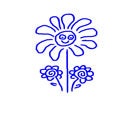USDA Plant Zones
What is My Plant Zone? aka ... Every plant can NOT be grown every where!
Below is a map of the United States showing the USDA Planting Zone classifications. It is an easy-to-use guideline for the climatic conditions relevant to plant growth and survival. It is used by gardeners to determine what plants will grow best in their Zone.
How to Use the Hardiness Zone Map:
By understanding the average climate in your particular area, you can easily determine those plants that will flourish in your area, and of course, identify the non-hardy ones that will not thrive in your yard. For example, a Tropical plant that loves the hot sun and high humidity of Southern Florida should definitely NOT be planted outdoors in the extreme cold of northern Minnesota. Makes sense, right?
To help its population find the best suited plants for their particular location, the map is divided into several "Planting Zones". These are numbered 1 through 13.
Zone 1 indicates the coldest northern areas of the USA. Plants must be extremely hardy varieties to withstand temperatures of -50 deg F (-45 C) in winter. Brrr.. this Zone has long cold windy snowy winters. On the opposite side of the spectrum is Zone 13. Few people in the USA live in Zone 13 because it is a subtropical locale, think the "island life" of bikinis, pina coladas & bananas!
The rest of us most likely live somewhere in between, basically in Zones 2-11.
So, how do I know which Zone my yard is in?
That's easy: Find your Zone on the map below, or follow the USDA link below, to enter your zip code directly on the USDA website:
Then, simply shop for plants that thrive in your Hardiness Zone. You will find this information within each plant's descriptive data.
Worth mentioning:
This map is quite accurate yet these planting Zones are not perfect. Microclimates do exist within the hardiness Zones. These microclimates may contain variations in humidity, heat, wind, soil, or moisture -- all are factors that can affect how well a plant will grow in that location.
Many times, you will find a range of Zones on a plant's description, and this simply means that the plant is hardy in more than one Zone. For example, Zone 4-8 means the ideal climatic conditions exist in Zones 4, 5, 6, 7, and 8. The plant will not thrive in Zone 3, 2, or 1 where it is too cold and it won't thrive in Zone 9, 10, 11, 12, or 13 where it is too hot.
And lastly yet obviously, it takes more than a Zone for a plant to thrive: Be sure to read the recommended CARE GUIDES, too! Experienced gardeners know that plants also have individual needs for sunlight, water, and soil minerals.
 USDA Plant Hardiness Zone Map, 2023. Agricultural Research Service, U.S. Department of Agriculture. Accessed from https://planthardiness.ars.usda.gov/
USDA Plant Hardiness Zone Map, 2023. Agricultural Research Service, U.S. Department of Agriculture. Accessed from https://planthardiness.ars.usda.gov/
